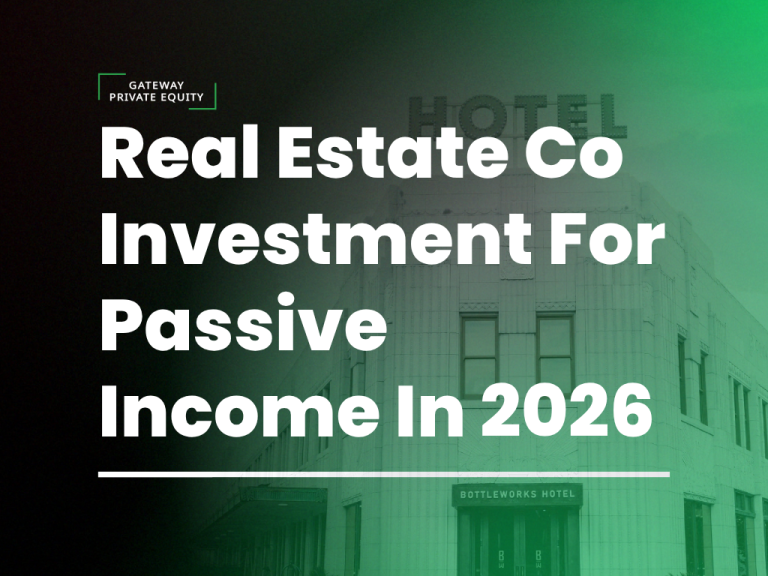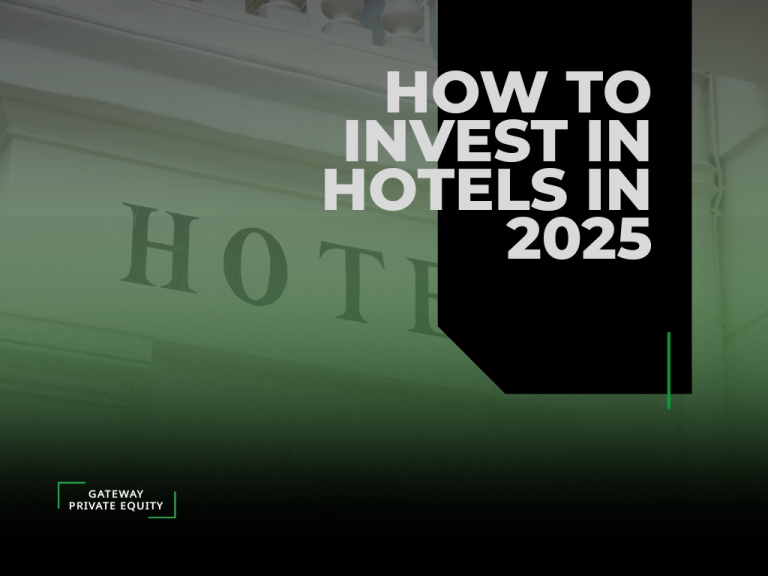Best Passive Real Estate Investments For 2026

Over twenty years ago, the only way I knew to get started in real estate investing was to be active. That meant doing everything ourselves, like finding properties, hiring maintenance, and managing tenants. Our business didn’t really start to grow until Mike went into real estate investing full-time.
But not everyone has that kind of time. You might be working 40+ hours a week, raising a family, and handling other responsibilities. Real estate investing is a business, and many people don’t want to run a business while also working a W-2 job. Or maybe you’re like me, where you enjoy your work but also know it makes sense to build other sources of income now instead of relying only on savings later.
That’s where passive real estate investing comes in. There are three main ways to approach it, depending on your financial goals and what you want to accomplish. I go over each of them here.
Table of Contents
Overview of passive real estate investments
Passive real estate investing lets you build wealth through property appreciation and rental income without the hassle of daily management. You’re partnering with experts who handle the details while you stay hands-off and focus on other things like your full-time job, traveling, or time with family.
Active vs. passive real estate investing
You can invest in real estate in two different ways.
Active real estate investing
Active investing means you’re directly involved in managing properties and tenants. It’s hands-on and time-intensive and can take 5 to 10 hours a week or more. You’ll need solid property management knowledge to handle everything from tenant screening to maintenance and financial decisions.
Even if you hire a property management company, you still need to stay involved. Sometimes their priorities don’t fully align with yours. For example, they might focus on filling units fast instead of finding quality tenants, or approve maintenance work without checking if it’s really needed. Both of those scenarios can cost you money and hurt your returns.
Owning an investment property this way can lead to higher returns, but it also brings more responsibility. If a tenant doesn’t pay, you have to deal with the eviction process. And when there’s a maintenance issue, you’re the one coordinating the fix.
Passive investing
Passive investing means you’re not the one running the show. The management team takes care of the property, handles tenants, and deals with maintenance. You might spend an hour or two a month checking updates or reviewing your returns.
You don’t need much real estate experience for this type of investing. The returns can be steady, and you’re not involved in the day-to-day decisions.
A quick summary of the differences:
| Aspect | Active | Passive |
|---|---|---|
| Time Required | 10-20+ hours/week | 1-2 hours/month |
| Capital Needed | $50,000+ per property | $500-$100,000 minimum |
| Expertise Level | High | Low to moderate |
Ways to passively invest in rental properties
Three main vehicles you can use for passive real estate investments include:
Real estate investment trusts (REITs)
REITs enable you to buy shares in publicly traded companies that own and operate rental properties. These companies also must distribute 90% of taxable income to shareholders, which can give you regular dividend income.
This is a very liquid investment that you can sell at any time. But you don’t get access to any of the tax benefits that you would get from owning physical property.
Key features:
- Historical performance: 9.7% average annual returns since 1971
- Minimum investment: As low as one share, which can be $20-200.
- Liquidity: Trade like stocks during market hours.
- Types: Equity REITs own properties and Mortgage REITs, which finance real estate.
You can also look at REIT exchange-traded funds for instant diversification across multiple properties and geographic markets.
Crowdfunding platforms
These platforms let you invest in professionally managed rental properties. You handle everything through the site, from reviewing documents to submitting your investment. This route gives you equity in a specific investment property and allows you to access real estate tax benefits.
Key features:
- Equity crowdfunding: With this type of passive investment, you own fractional property interests.
- Debt crowdfunding: This investment type gives you fixed returns from real estate loans.
- Target returns: Usually about 8-10% per year.
- Minimum investment: Usually $1,000-$100,000, depending on the platform and deal.
Be sure to evaluate sponsor track records because platform quality varies significantly. Look for experienced operators with transparent reporting.
Real estate syndications
With real estate syndications, your money gets pooled with other investors to buy larger commercial properties. You’ll have a direct relationship with the project sponsor and benefit from real estate tax advantages.
Key features:
- Accredited investors: Most syndications require you to be an accredited investor. This means you have either $1M+ net worth or $200K+ annual income.
- Higher minimums: Investment minimums usually start at $50,000.
- Investment period: The hold period is usually 3-7 years with limited liquidity.
- Returns: Potential for 12-20% IRR through cash flow and appreciation.
A big advantage of syndications is direct property ownership. This gives you passive real estate income along with tax benefits like depreciation and 1031 Exchanges.
Your due diligence should include looking at the sponsor’s experience, market fundamentals, property condition, and how feasible the exit strategy is.
Here’s a quick summary of passive real estate investing options:
| Type | Pros | Cons |
| REITs | Easy to buy and sell like a stock. Low minimums. Reliable dividends. Broad mix of properties. | No property tax breaks. Prices can move with the stock market. You have no control over assets. |
| Crowdfunding platforms | Lets you join large projects online. Choice of equity or debt. Some tax advantages. Smaller starting amounts. | Money stays in the deal until it ends. Quality depends on the platform. Returns vary by project. |
| Real estate syndications | Gives direct ownership and strong tax perks. Often higher returns. Managed by professionals. Passive income stream. | Usually, only accredited investors. High minimums. Funds stay in for several years. Hard to exit early. |

Technology’s impact on passive real estate opportunities
Technology and new regulations have opened the door for everyday investors to access deals that used to be reserved for institutions. Before 2012, you had to know the right people or meet strict financial requirements to invest in large commercial properties. The JOBS Act changed that by allowing sponsors to publicly raise capital online. That’s what made real estate crowdfunding possible.
Fintech took it further. Online platforms now handle everything from verifying accreditation to signing documents and tracking performance. You can review detailed offering materials, compare deals, and invest with just a few clicks. What used to take months of phone calls and legal work now happens in minutes.
Because of these changes, investors can now build real estate portfolios without managing a single property. You still get professional oversight and access to institutional-quality assets, but without the barriers that once kept most people out of the market.
Real estate strategy and portfolio diversification
Real estate has consistently proven to be one of the most reliable ways to build long-term wealth. Property values tend to rise over time and can generate income even when the stock market moves up and down.
That mix of growth and income is why investors keep real estate in their portfolios. It helps balance risk and smooth out returns when other assets fluctuate.
Historical performance comparison of passive income vehicles
Here’s a quick comparison of passive real estate investments to the stock market:
| Investment Type | Annual Returns | Time period |
|---|---|---|
| REITs | 9.7% | Since 1971 |
| Direct real estate | 10.7% | Since 2000 |
| Real estate crowdfunding | 8-10% | Target Range |
| Real estate syndications | 10-15% | Typical 5-year |
| S&P 500 | 10.0% | Long-term average |
Real estate investing strategies to reduce portfolio risks
Real estate doesn’t move the same way stocks or bonds do. Its correlation with stocks usually falls between 0.2 and 0.4, and it’s almost zero with bonds. That means when the stock market drops, real estate often holds steady.
That’s why real estate is a great way to balance your portfolio and add stability when other investments experience volatility.
How much to allocate to real estate investments
A good rule of thumb is to allocate about 10-20% of your portfolio to real estate investments. The actual range depends on your risk profile. Example allocations include:
- Conservative investors: 10-12%
- Moderate risk tolerance: 15-18%
- Aggressive portfolios: 18-20%
Diversifying your real estate investments
As you build out a real estate portfolio, there are several ways you can diversify your investments to generate passive income, no matter what is happening in the market. Here’s how:
Diversify real estate markets
You can start by putting part of your portfolio into international markets. It’s a good way to spread risk and protect yourself from what’s happening with the U.S. dollar, national debt, and inflation. If the dollar weakens, assets in other currencies can hold their value or even increase when converted back.
That’s one reason we’re focused on boutique hotels in Spain. The market there is strong, tourism keeps growing, and real estate prices are still well below what you’d find in the U.S. It’s a way to diversify, earn in euros, and gain exposure to a healthy market that isn’t tied to U.S. debt concerns.
Geographic allocations:
- 60-70% domestic markets
- 30-40% international exposure
Asset class allocation:
We’re in hotels, but that doesn’t mean every real estate investor should be in that asset class. It’s a good idea to diversify your investment mix. For example:
- Multifamily: This asset class provides steady income because there’s always a demand, and we currently have a shortage of housing supply in most areas of the country.
- Office: Ever since COVID-19, office has been one of the most challenging asset classes due to the rise of remote work. Still, a good property in the right location can be a good investment.
- Industrial: The rapid growth of e-commerce created a huge demand for industrial properties to store goods.
- Specialty: This category includes hotels, self-storage, and other niche investments like medical office buildings.
- Data centers: With the rush to build infrastructure to support AI, data centers are one of the best real estate investments if you can find opportunities.
Potential tax benefits of real estate investments
Real estate has some of the best tax benefits of any investment. It can also help you keep more of your income and protect your money from inflation. Here’s how:
Tax advantages
Some of the programs you can use to reduce your taxes include:
- Section 199A deduction: You can receive a permanent 20% qualified business income deduction on rental real estate income, which reduces your effective tax rate.
- Enhanced depreciation: 100% bonus depreciation is now permanent for qualifying property. This gives you immediate write-offs for improvements and equipment
- 1031 Exchanges: One of the best strategies around, a 1031 Exchange allows you to defer capital gains taxes indefinitely when you buy a similar or larger property.
- Tax-Advantaged accounts: You can use self-directed IRAs to invest in real estate with tax-deferred or tax-free growth.
- SALT Cap Relief: This is a state and local tax deduction cap of up to $40,000 on state and local taxes you paid, making it easier to save on federal taxes if your property and state taxes are high.
Inflation protection with real estate projects
- Rent escalation clauses: A property manager usually includes annual rent increases in every lease. These are tied to inflation or market rates to make sure income growth matches rising costs.
- Fixed-rate debt: Locking in today’s rates means you’ll pay back your loan with cheaper dollars in the future. As prices and rents go up, your payments stay the same, which helps you come out ahead.
- Depreciation shield: Your depreciation deductions stay the same while your rental monthly income rises with inflation. This is a powerful approach to building wealth.
Distribution benefits
Real estate syndications pay investors rental income that gets a tax break from the Section 199A deduction, which can lower taxes by up to 20%. When you sell, any tax benefit from depreciation gets taxed at lower capital gains rates.
Starting in 2026, you can also pass on larger amounts to heirs without estate taxes, so you can keep wealth in your family.
Risks and due diligence
“Passive income” doesn’t mean passive oversight, so you’ll need to do due diligence for successful investments. Here’s how:
Key areas of risk
Liquidity
Real estate investments aren’t as liquid as stocks or bonds. You can’t just sell your share whenever you want. Most deals have a hold period of five to ten years, which means your money stays in until the property sells or refinances.
If you need quick access to cash, that can be a challenge since early exits are usually limited or not allowed at all.
Market cycle impacts
Real estate moves in cycles, just like the broader economy. When the market slows down, property values can drop, and it might take longer to sell or refinance. During those times, distributions can shrink or pause until conditions improve.
Every property type feels it differently, but no real estate investment is completely immune to the market cycle.
Platform & sponsor risk
When you invest through a crowdfunding platform or syndication, you’re also trusting the people running it. If the platform has financial issues, it can affect your investment. The sponsor’s experience and track record matter just as much since they’re the ones making key decisions about the property.
It’s important to make sure they know what they’re doing and have managed deals successfully before. Strong operations and solid communication can help protect investors when challenges come up.
Passive real estate investing due diligence checklist
Here is a checklist you can use to vet passive real estate investments:
- Track record: Look at how the sponsor has performed through different market cycles, not just in good years.
- Fees: Know exactly what you’re paying in fees. This includes acquisition, management, and disposition fees.
- Compliance: Make sure the deal follows SEC rules and state regulations.
- Exit plan: Understand how and when the property will be sold or refinanced.
- Leverage: Check how much debt the sponsor is using and how sensitive the deal is to rising interest rates.
- Market: Review the local market, job growth, and demand trends to see if they support the business plan.
Technology and 2025 trends
As someone who works in the tech space, I’m always interested to see how technology is changing different industries. Real estate investing also benefits greatly from digital enhancements and new capabilities. Some of the key trends are:
- Artificial intelligence: AI tools can analyze huge amounts of market data in seconds. They compare properties, spot trends, and flag risks that people might miss. This helps investors move faster and make smarter decisions.
- Blockchain: This technology is changing how fractional ownership works. Through tokenization, investors can buy into high-value properties with smaller amounts of capital.
- Mobile: Investment platforms and apps now give you access to property details and performance data right from your phone, making it easier to track and manage your portfolio on the go.
- ESG: This growing area of technology helps investors evaluate how sustainable a property is and understand its broader social impact.
Take action to build your passive real estate portfolio
Start by evaluating your current portfolio’s real estate allocation. If you’re new to passive real estate investing, you might want to start with REITs as an easy way to diversify your investments. Then, as you get more comfortable and grow your savings, take a look at real estate crowdfunding platforms and syndications.
Immediate next steps:
- Decide on how much capital you’re willing to invest and when you want to invest.
- Research opportunities either with publicly traded REITs or with syndicators.
- Check with financial advisors who are experienced in passive real estate strategies.
- Allocate 5-15% of your portfolio to whichever real estate investment strategy you’ve decided on.
Final thoughts on passive real estate investing
If you’re someone who read Rich Dad Poor Dad or another book about building financial freedom and creating a financial safety net beyond your day job, real estate investing is one of the strongest ways to do it. But if you don’t have the time, experience, or upfront capital to buy your first rental property, passive investing can be a smart way to start.
The key is doing your due diligence and taking time to research what fits your financial situation. If you’ve been thinking about getting into syndicated real estate deals, connect with us here. We’re happy to walk you through how it works to see if it’s a good fit for you.
Or, click here for info on our latest hotel fund for boutique hotels in Barcelona, Spain.
Passive real estate investments: FAQs
How to make $100,000 a year in passive income?
To make $100,000 a year in passive income, look at the return each investment is expected to earn. If a project averages about a 10% annual return, you’d need around $1 million invested to hit that number. The goal is to put your money into projects that actually produce a regular income stream.
What is the 7% rule in real estate?
The 7% rule means your yearly rent should be about 7% of what you paid for the property. It’s a quick way to see if a deal might make sense. For example, a $400,000 property would collect $28,000 in rent each year. Keep in mind this doesn’t include expenses and doesn’t guarantee a profit.
What is the best type of real estate for passive income?
There isn’t one perfect type of real estate for passive income. The best type is any property that consistently brings in more income than it costs to own and operate.
The information in this post is for informational purposes only and should not be considered tax or legal advice. Please consult with your own tax professionals and advisors before making any decisions or taking action based on this information.






